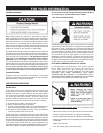
14
THERMAL EXPANSION
Water supply systems may, because of such events as high line
pressure, frequent cut-offs, the effects of water hammer among others,
have installed devices such as pressure reducing valves, check valves,
back flow preventers, etc. to control these types of problems. When
these devices are not equipped with an internal by-pass, and no
other measures are taken, the devices cause the water system to be
closed. As water is heated, it expands (thermal expansion) and closed
systems do not allow for the expansion of heated water.
The water within the water heater tank expands as it is heated and
increases the pressure of the water system. If the relieving point of
the water heater’s temperature-pressure relief valve is reached, the
valve will relieve the excess pressure. The temperature-pressure
relief valve is not intended for the constant relief of thermal
expansion. This is an unacceptable condition and must be corrected.
It is recommended that any devices installed which could create a
closed system have a by-pass and/or the system have an expansion
tank or device to relieve the pressure built by thermal expansion in
the water
system. Expansion tanks are available for ordering through
a local plumbing contractor. Contact the local water heater supplier
or service agency for assistance in controlling these situations.
STRANGE SOUNDS
Possible noises due to expansion and contraction of some metal
parts during periods of heat-up and cool-down do not necessarily
represent harmful or dangerous conditions.
OPERATIONAL CONDITIONS
WATER ODOR
In each water heater there is installed at least one anode rod (see
parts sections) for corrosion protection of the tank. Certain water
conditions will cause a reaction between this rod and the water.
The most common complaint associated with the anode rod is one
of a “rotten egg smell” in the hot water. This odor is derived from
hydrogen sulfide gas dissolved in the water. The smell is the result
of four factors which must all be present for the odor to develop:
A. A concentration of sulfate in the supply water.
B. Little or no dissolved oxygen in the water.
C. A sulfate reducing bacteria which has accumulated within the
water heater (this harmless bacteria is nontoxic to humans).
D. An excess of active hydrogen in the tank. This is caused by the
corrosion protective action of the anode.
Smelly water may be eliminated or reduced in some water heater
models by replacing the anode(s) with one of less active material, and
then chlorinating the water heater tank and all hot water lines. Contact
the local water heater supplier or service agency for further information
concerning an Anode Replacement Kit and this chlorination treatment.
If the smelly water persists after the anode replacement and
chlorination treatment, we can only suggest that chlorination or aeration
of the water supply be considered to eliminate the water problem.
Do not remove the anode leaving the tank unprotected. By doing
so, all warranty on the water heater tank is voided.
“AIR” IN HOT WATER FAUCETS
HYDROGEN GAS: Hydrogen gas can be produced in a hot water
system that has not been used for a long period of time (generally
two weeks or more). Hydrogen gas is extremely flammable and
explosive. To prevent the possibility of injury under these conditions,
we recommend the hot water faucet, located farthest away, be
opened for several minutes before any electrical appliances which
are connected to the hot water system are used (such as a
dishwasher or washing machine). If hydrogen gas is present, there
will probably be an unusual sound similar to air escaping through
the pipe as the hot water faucet is opened. There must be no smoking
or open flame near the faucet at the time it is open.
HIGH WATER TEMPERATURE SHUT OFF SYSTEM
A non-adjustable high temperature limit control operates
before steam temperatures are reached. The high limit is
in the same area as the upper thermostat and must be
reset manually when it operates. BECAUSE THE HIGH LIMIT
OPERATES ONLY WHEN ABNORMALLY HIGH WATER
TEMPERATURES ARE PRESENT, IT IS IMPORTANT THAT A
QUALIFIED SERVICE AGENT BE CONTACTED TO DETERMINE
THE REASON FOR OPERATION BEFORE RESETTING.
• Turn off the heater electrical supply. Do not attempt to reset
thermostat with power on.
• Remove the screw(s) securing the outer door and remove door.
• Remove or fold up the insulation to expose the reset button.
• Reset the high limit by pushing in the red button marked “RESET”.
• Replace the insulation so that it completely covers the thermostat
and element.
• Replace the outer door.
• Turn “ON” electric power to the water heater.
FOR YOUR INFORMATION


















